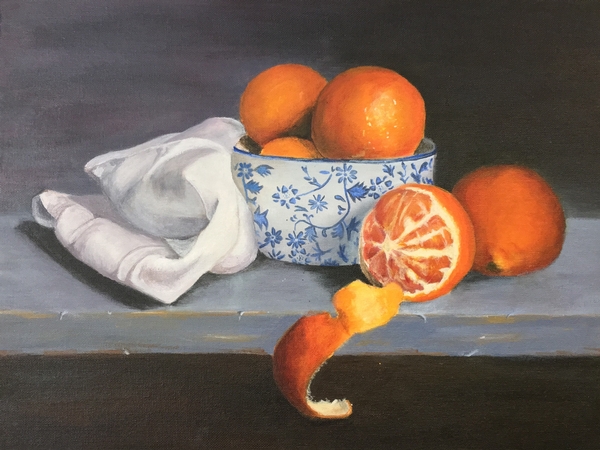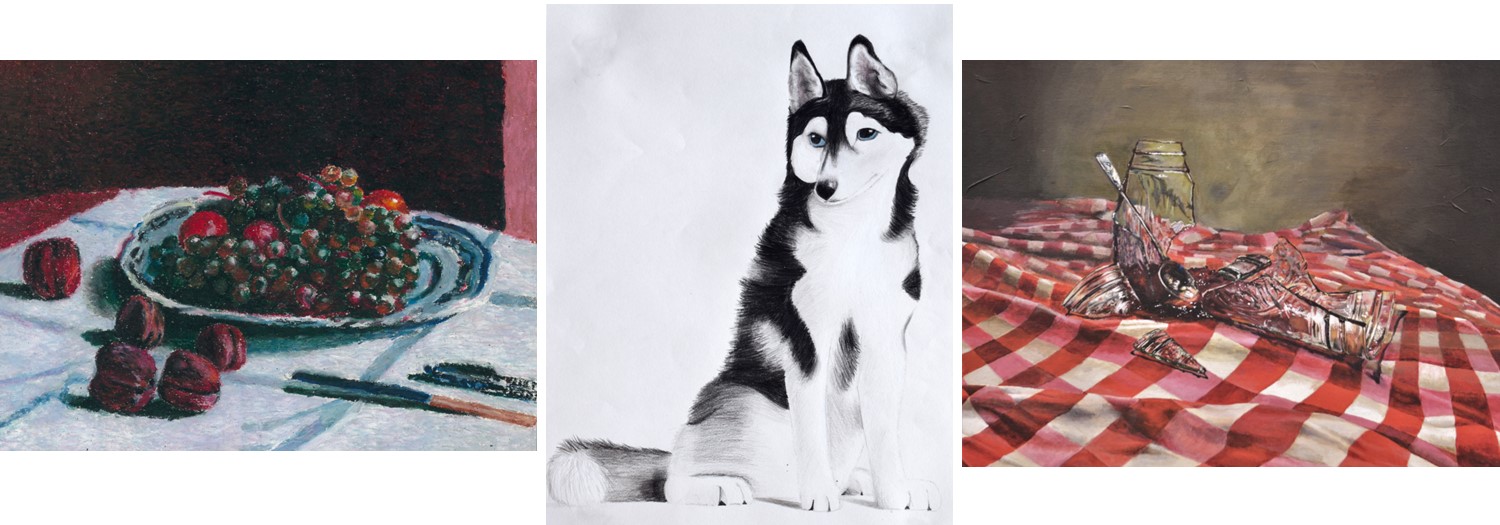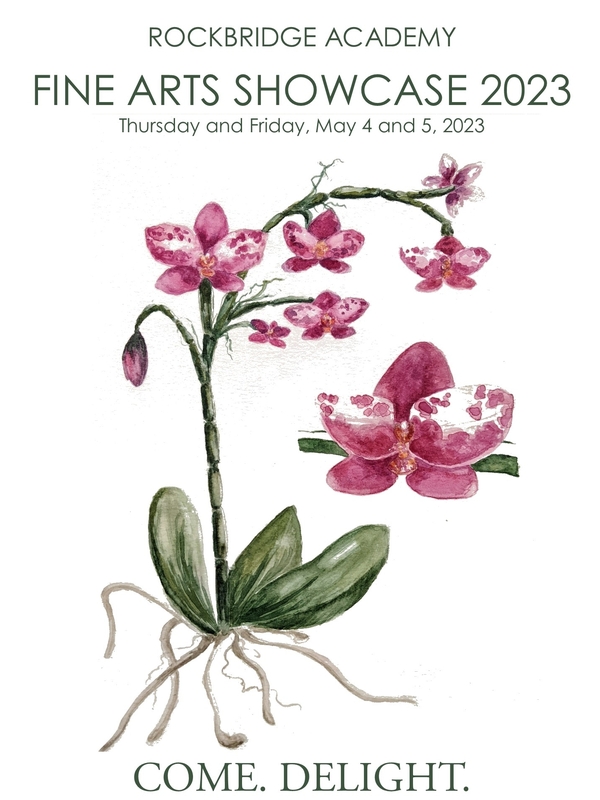Rockbridge Academy Blog
Art, of Course! Four Tenets of Classical Christian Art

In art, we are ultimately educating students toward a deeper knowledge and love for God and our neighbor. We are teaching a fear of the LORD which is the beginning of wisdom (Proverbs 9:10). In Hebrew the word for “wisdom” means “skillful with the hands,” evoking handiwork done with care and knowledge.
Rockbridge Academy has a weekly art course, from grades 1 through 8 as well as a chosen elective for grades 7 through 12. We invest time in the schedule, space in the building, and money in the budget. We grade participation, memorization, worksheets, and projects. Art is taught classically at a grammar, dialectic, and rhetoric level. We know this high view of art education is counter-cultural since we witness art and music being the first courses that drop during a time, space, or budget crunch. Yet, here it is, art as a cherished part of education, not as a “second recess.” John Ruskin said, “Fine art is that in which the hand, the head, and the heart of man go together.” Thus, classes elicit the student’s concentration and diligence, encouraging their best work with carefulness and neatness. In this environment students can produce their best work with a sense of delight: “Aaah, I did that—and it is good!” This sentiment should evoke thoughts of our Creator. An inescapable fact of our humanity is that we bear the image of God and thus have a deep desire to create good work with joy and thanksgiving. Genesis 1:31 states, “And God saw everything that He had made, and behold, it was very good.” In this article I describe four attributes or goals of a classical, Christian art education. There may be more, but these stand out as foundational. Thus, I am calling them the four tenets of a classical, Christian art course.
1. See and Apprehend God’s Glory
The first tenet of a classical, Christian art education is to help students see and apprehend God’s Glory. That is, to show the excellence of His character and providence in our finely-tuned, complex creation. The Westminster Confession of Faith states, “The chief end of man is to glorify God and enjoy Him forever.” There is true enjoyment in gratefully appreciating God’s creation, learning to observe it well with joy. Theologians describe two “books” of God’s Glory: Creation and Scripture. Psalm 34:8 and Psalm 19:1-4a state:
“Oh, taste and see that the LORD is good!
Blessed is the man who takes refuge in him!
The heavens declare the glory of God;
The skies proclaim the work of His hands.
Day after day they pour forth speech,
night after night they reveal knowledge.
They have no speech, they use no words;
no sound is heard from them.
Yet their voice goes out into all the earth,
their words to the ends of the world.”
In art, we are ultimately educating students toward a deeper knowledge and love for God and our neighbor. We are teaching a fear of the LORD which is the beginning of wisdom (Proverbs 9:10). In Hebrew the word for “wisdom” means “skillful with the hands,” evoking handiwork done with care and knowledge. As students learn to carefully observe the world, they perceive its intricate complexity. They notice patterns, symmetry, proportions, rhythms, ratios, and harmonies. Students witness the Golden Ratio, the Fibonacci Sequence, and many varied sophisticated designs in forests, feathers, and our double-helix DNA strands, for example. All of creation speaks visually of our gracious, kind Creator who is all-powerful, sovereign, and trustworthy. Students may begin to understand why the angels, the Seraphim call to one another, “Holy, Holy, Holy is the LORD Almighty, the whole earth is FULL of His Glory!” (Isaiah 6:3).
2. Understand the Flow of Art History
The second tenet of a classical, Christian art course is that it is based on the flow of art history. Here is another view of God’s story. Students can begin to understand the progression of world views through history as they are seen in various cultures’ artwork. For example, how do we know what the Egyptians believed to be true or important except through the art which is left for us to observe and study? And consider, is there a reason why one art era moved to another? As we study reactions to various world views, we can see what could be happening as the philosophy of cultures change through time.
Students also notice that some aspects of humanity are similar throughout time and space, pointing again to our Maker. For example, all over the world, and since the earliest of times, mankind has sought a God or gods, felt closer to Him or them on a mountaintop, and felt a debt, a need to sacrifice, to give to this higher power. Where did all this come from? Ecclesiastes 3:11 says, “He has made everything beautiful in its time. He has also set eternity in the human heart; yet no one can fathom what God has done from beginning to end.”
The students witness themselves being part of an extremely large picture. They gain an understanding of the foundation and rise of Christianity. They realize they are not alone, they live in community, in a continuum of time, connected to a legacy of thought. It is like witnessing a very long conversation with many members from the beginning of time. This aspect may not seem important but consider that one of the goals of public education is to dispel this truth. John Gatto was awarded New York Teacher of the Year in 1990 and 1991. His revealing book, Dumbing Us Down describes his classes this way: “The first lesson I teach is confusion. I teach everything out of context… I teach the un-relating of everything. I teach disconnections. I teach too much: the orbiting of planets, the law of large numbers, slavery, adjectives, dance, surprise guests, pull-out programs, standardized tests… What do any of these things have to do with each other?” Their goal is for students to witness disconnection and confusion, not order and harmony. I recall Dostoyevsky’s revelation in The Brothers Karamazov, “the awful thing is that beauty is mysterious as well as terrible. God and the devil are fighting there, and the battlefield is the heart of man.” Consider now that an objective of public education is to use various subjects to purposely instill chaos, confusion (babel), not connection, peace, or wisdom. This is an intentional strategy of the enemy to dismiss the beauty of God, including the beauty of creation and divide the community we have with one another.
3. Integrate Other Subjects with Art
This is where I declare that I have the BEST job at Rockbridge Academy: teaching art! Various parts of all subjects come together in our art lessons revealing an orderly whole. These connections are unavoidable and they are unexplainable without considering the work of a powerful Creator…Look for it with me—there is art in every subject and every subject in art.
And here we have a smooth segue to the third tenet of a classical, Christian art course: Integration. Rather than disintegration, art lessons reveal integration across subjects. Truly, we live in a universe, not a pluriverse. As teachers, we are intentional in revealing integration. This is where I declare that I have the BEST job at Rockbridge Academy: teaching art! Various parts of all subjects come together in our art lessons revealing an orderly whole. These connections are unavoidable and they are unexplainable without considering the work of a powerful Creator. We’ve already seen a connection of art with history, geography, philosophy, and Bible. Consider also the many Latin root words we review. Proportion is a stem of “proportio” meaning an analogy of parts. Duplication is to draw something a second time. Chroma is color. Primary colors are the first ones. The list goes on and on. Additionally, we often have math lessons. We teach value as the weight of black and white, or of a color. We literally work on geometry while studying shape, form, perspective, and ellipses. We also consider science since artists study nature to draw it well. It wasn’t too long ago that to be a great scientist you had to be a great artist—drawing what you saw in the natural world. Artists were chemists as well, mixing their own paints. We connect our color and composition lessons easily with music: rhythm, patterns, harmony, disharmony. After all, tone is color. I recall my daughter describing a lesson her music teacher at the time (Mrs. Ball) gave to the choir, “that is a bright red tone, try to make it more of a mauve…” This instantly communicated a more correct harmony. Finally, as art teachers, we require our students to write well, not just with proper spelling and grammar, but with their neat handwriting. Look for it with me—there is art in every subject and every subject in art.
4. Teach Skills of the Craft
Lastly, the fourth tenant of a classical, Christian art course is simply that we teach definite skills of the craft. In other words, we do not hand students a blank paper and ask them to draw whatever they feel. Oh, how overwhelmingly self-conscious and intimidating that could be. Rockbridge Academy’s art curriculum is purposely drawing-heavy. Our lessons begin (and continue) with, “draw what you see, not what you think you see.” Students grow in their ability to patiently draw with accuracy. They may grow-up to become an artist or they may just need to confidently draw what they see in a microscope, doing so without fear, being able to gain an even deeper understanding of what they are seeing by drawing it correctly.
Classical in nature, our art education involves students imitating forms in life and duplicating other masterpieces. They grow throughout the curriculum and move toward greater sophistication. We seek to generate enthusiasm, joy, and wonder as well as provide lessons in real skills for the students to practice, real information for them to learn, sensing a real love that we have for them as our students and for God as LORD of creation, and God of Wonder.
All this work and wonder is wrapped up nicely in the spring when the Rockbridge Academy community comes together to enjoy the Fine Arts Showcase. Don’t miss it.
Take a look at the past Rockbridge Academy Blakey Prize winners HERE.
Therese Cooley, upper school art teacher, has been a part of the Rockbridge Academy faculty and staff since 2006. She has also taught grammar school art and the photography elective and helped with the yearbook and communications over the years. She and her husband, Roger, have five Rockbridge alumni children and four precious grandchildren.

Making Room for Beauty

“Truth, Goodness, and Beauty.” If you’ve been around Classical Christian Education for more than a minute, you’ve probably noticed that we love to say these words. These three transcendentals, lauded by the philosophers of classical antiquity and rightly located by theologians in the very nature and being of God, are an apt rallying cry for the work of classical Christian education.
Still, some of us may have a more ready apology for truth and goodness than we do for beauty. We point to God’s Word as the source of truth and acknowledge Him as the One who defines all the reality of the cosmos. “All truth is God’s truth,” we rightly say. We recognize how God reveals Himself as we happily pillage the best sources of knowledge from across the ages. Likewise, we acknowledge that goodness is in and of God, both in terms of morality and blessing. The Greeks conceptualized “good” as that which fulfills its own purpose, and we find in our Creator one whose perfect purpose is actively revealed to us in His character and His work of redemption. Just as with truth, we recognize God wants us to know and explore His goodness; in fact, we cling, like David, to the comfort that “surely goodness and mercy” will pursue us all the days of our lives.
But what of beauty? Do we defend and cleave to beauty with a similar conviction? Do we remember that this third member of the triumvirate is also located in God and that He uses beauty in His pursuit of us? After all, “Beauty is in the eye of the beholder” rolls so easily off the tongue, and experience tells us that there is variety and gradation in people’s aesthetic preferences. Since there’s no accounting for taste, don’t we hit a dead-end with beauty?
Swiss theologian Hans Urs von Balthasar commented on this tendency to quietly sideline considerations of beauty when he said:
Beauty is the last thing which the thinking intellect dares to approach, since only it dances as an uncontained splendor around the double constellation of the true and the good and their inseparable relation to one another. Beauty … without which the ancient world refused to understand itself, [is] a word which both imperceptibly and yet unmistakably has bid farewell to our new world.
Even many Christians, Balthasar says, have functionally jettisoned beauty from the realm of the essential. He gives a somber warning about the consequence of this devaluing:
We no longer dare to believe in beauty and we make of it a mere appearance in order the more easily to dispose of it. Our situation today shows that beauty demands for itself at least as much courage and decision as do truth and goodness, and she will not allow herself to be separated and banned from her two sisters without taking them along with herself in an act of mysterious vengeance.
We can be grateful that there is a conscious intention at Rockbridge Academy—and in the broader classical Christian education movement—to guard against the easy “disposal” of beauty about which von Balthazar soberly warns. “Truth, Goodness, and Beauty” isn’t just a catchy slogan. It’s a shorthand reminder of a Trinitarian truth: we are made in the Imago Dei, with intellectual, moral, and aesthetic sensibilities and desires. Thus, in the classroom, asking “What is Beautiful?” is just as worthwhile as asking “What is True?” and “What is Good?”.
Classical Christian education allows breathing room for such discussions. On the one hand, our “classical” bent reminds us that, in the tradition of the best thinkers from across the ages, pursuing a better understanding of beauty helps us explore what it means to be fully human. On the other hand, our unapologetically “Christian” emphasis reminds us that the answers we seek are ultimately found outside ourselves. While God created us with individually nuanced tastes and pleasures, He is our ultimate reference for what is beautiful. Embracing this juxtaposition of imminence and transcendence in the beautiful, good, and true (and valuing their inescapable connection to one another) is a part of the very good work—the “courage and decision”—going on at Rockbridge Academy, by the grace of God.
Embracing this juxtaposition of imminence and transcendence in the beautiful, good, and true (and valuing their inescapable connection to one another) is a part of the very good work—the “courage and decision”—going on at Rockbridge Academy, by the grace of God.
Heidi Stevens taught art and humanities courses for twenty years and now serves on the Rockbridge Academy Board of Directors. She and her husband, Rick, have two grown daughters, both Rockbridge graduates.
